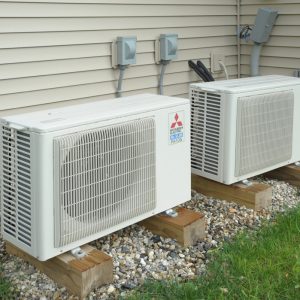High-Performance HVAC
Ductless minisplit heat pumps are becoming the go-to choice for heating and cooling in well-insulated, tight houses.

Few pieces of heating and cooling equipment have won as much attention in the last few years as the ductless minisplit, a variety of air-source heat pump that’s often the first choice of builders who specialize in all-electric, high-performance houses.
Air-source heat pumps have long been an HVAC staple in the Southeast, where winters are relatively mild and the need for air conditioning is high. But new-generation heat pumps, pioneered by such companies as Mitsubishi, Daikin, and Fujitsu, are capable of operating efficiently in much lower temperatures than those old standbys. Many of them can produce heat when outdoor temperatures are 10° or more below zero.
Unlike conventional heat pumps, these newer versions have inverter-driven, direct-current compressors that can operate at different speeds—not just “on” or “off”—so output better matches demand. Tests by the National Renewable Energy Laboratory found that the coefficient of performance (COP) ranges from 2 to 7 depending on the outdoor temperature, meaning the heat pumps were from two to seven times as efficient as electric-resistance heat.
Minisplits come in two versions—ductless and ducted. Both can heat and cool. A ductless minisplit consists of an outdoor compressor and an indoor head (a fan-coil unit) that’s mounted on the wall or the floor. Ceiling-mounted cassettes are another option. There are no supply and return ducts that you’d find on a conventional forced-air system. One or two heads might be enough to heat and cool entire house, provided the house is very well insulated and has very low air-leakage rates. A single outdoor compressor can supply a number of indoor units.

A Massachusetts builder named Carter Scott did much to popularize ductless minisplits by building a high-performance house and heating and cooling it with just two minisplit heads. These units he used were rated at just 12,000 Btu/hour, compared with a furnace or boiler that might be rated at 80,000 Btu/hour in a conventionally built home. At the time, it seemed a stretch of the imagination that two minisplits would be able to keep the house warm on a frigid winter night, but many builders since have used Scott’s strategies to accomplish the same kind of performance. When paired with rooftop photovoltaics, the $5250 heating and cooling system eliminates utility bills.
Ducted minisplits are another, although less common, option. They are sort of a middle ground between a fully ducted furnace and a ductless minisplit. Their blowers are limited in power, so they are able to heat and cool a fairly limited zone with a single fan-coil unit and short runs of duct.
Ductless minisplits are good candidates for energy-system upgrades or adding whole-house air conditioning in houses that are heated with a hot water system. It’s easy to spot houses that have undergone this conversion: You’ll see a bulky white pipe traveling from the outdoor compressor up the side of the house. Inside, someone is happy to be burning less oil or natural gas and seeing lower energy bills.






View Comments
amazing
In California these ductless systems are becoming the standard type of system in higher end housing, and even in some production housing.
So I’m building a house with radiant heat in the floors, which is the prime source of heat. In Utah, I still need a robust air conditioning system to handle cooling about half the year, because we have some powerfully sunny days, even in October and May. But I’m thinking that a ductless split system could be ideal for me, because I am not overly reliant on the split system for heating, which is really the radiant hydronic system’s job. I’ve really just had a hard time finding an HVAC subcontractor that has significant experience installing ductless split systems in large homes. It seems like most HVAC subs here have experience with ductless limited to just retrofitting a few wall mount units in smaller, older homes. I need an HVAC sub with experience installing many units in a large new construction home, with the units being the slim low profile kind and hidden from view. Any recommendations anyone?
There's an interior designer in your area who may be able to help answer your questions. Her name is Shawn Simons: [email protected]. She seems to have answers to everything, or at least connections to people who can provide those answers. Good luck! We are going through something similar in Massachusetts.
We recently had a Mitsubishi minisplit installed in our upstairs addition (built in the 50's) in California. It is, indeed, incredibly efficient and QUIET. (The "quiet" part is the best selling point.)
From our experience, there are two things to be aware of if you go with ceiling units instead of wall units as we did:
1) They require condensate pumps, which, in our case, can be finicky. The drain lines need to be arranged carefully, otherwise you may have a continuously running pump. A gravity drain is simple and reliable, and probably does a better job with moisture in general.
2) Most likely, your ceiling unit will be in an "unconditioned space" such as a very hot attic. This will reduce its efficiency. You can make up for some of this loss by adding insulation and ensuring your attic is well ventilated. The system is so efficient overall that this may not be a huge concern.
I honestly haven't even noticed a change in our electric bill. Our location doesn't get very hot, however. We mostly use it so we can close our windows at night. What was once a hot, noisy upstairs bedroom is now a quiet refuge.